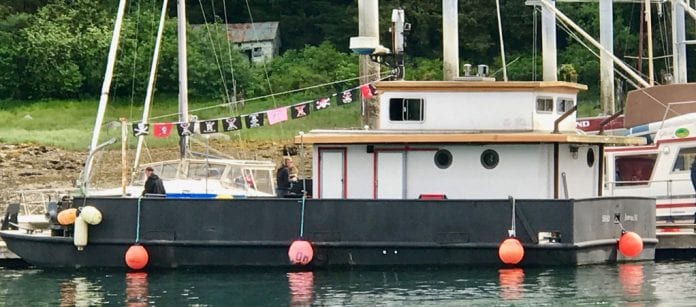
A trading post of the banks of Alaganik Slough, connected to the RR tracks by a boardwalk, plus an exposed rocky pinnacle and water tank, are visible in this photo taken before the Last week I wrote about much appreciated responses to Cordova Chronicles features. Here are a few more.
A May 2017 article titled “It’s all in the letters” was about the slow journey back from a halibut fishing expedition at Stawberry Channel in which the outboard on my 19-foot Hewescraft wouldn’t perform properly. At one point, my partner, Randy Bruce, mentioned we were going slower than the M/V Shad, a flat-bottomed metal scow-type ADF&G vessel he had crewed on with Harry Curran for a number of years back in the 60’s. It had later been replaced by the much bigger and faster M/V Montague, and more recently, by the M/V Solstice. Randy had no knowledge of the Shad’s whereabouts.

Photo courtesy of David & Misty Smith
A week after the article ran, I was surprised to receive an e-mail from David and Misty Smith in Juneau. Turns out the Shad had been purchased in early 80’s by another couple in Juneau, and in 2010 they became the second owners, “to use it as our floating Winnebago.”
Mrs. Smith went on to modestly state “she’s undergone some changes since the old ADF&G days.”
No kidding. I doubt very much that Captain Curran would even recognize the refurbished bridge area. Randy was amazed to see the remodeled craft and told me “Harry was a stickler about sea-faring traditions, including no whistling in the wheelhouse.”
So even today, despite all the technology, no music would be allowed to blare away while the vessel was underway with Harry in command.

But perhaps the most exciting photos to surface came from right here in Cordova. While helping the Cordova Museum transfer its vast collection of photos to digital format, dedicated local historians and volunteers Ira Grindle and Jim Casement discovered a number of photos of the landing and railroad water tank at Alaganik.
This was the very site of a two-part Cordova Chronicles series in January 2017 that covered the huge explosion of a dynamite shed on November 29,1947 that blasted a hole in the adjacent rock outcropping; shook buildings in Cordova, 22 miles away; and killed Jimmy LaGasa.
LaGasa, 24, caused the explosion by shooting at the shed with a rifle, and literally vanished. It forced his companion, Johnny Kulper, 16, accompanied by a nearby trapper, to walk back on the railroad tracks seeking help at Mile 13, as the blast sunk the boat he and LaGasa had used to reach the site.
One photo, which is taken looking back toward Cordova, shows cabins and an over-turned skiff on the banks of Alaganik Slough; as well as a boardwalk to the cabins, a wooden shed beside the tracks, and a tall rock pinnacle. A sign reading “Alaganik” stands beside the railroad tracks; and the railroad water tank is visible in the background.

A second photo shows the water tank in much greater detail. A small shed can be seen under the tank. A front-page story in the December 2, 1947 Cordova Times described the results of the explosion as “an incredible scene.” It also stated that “the powder house had been built within timbers supporting an old railroad water tank only about ten feet from the tracks, which ran through a roadbed cut in solid rock which rose over 30 feet.”

All the wooden structures are now gone. More noteworthy is the shape of the tall rock pinnacle. Its top was blasted away in the explosion. Even though the rocky knob is now covered with trees, the change in its shape is clearly evident in a photo taken by Grindle on January 19, 2018. It is safe to assume the wooden shed and water tank also vanished on that fateful day.
Webster’s Dictionary defines chronicles as “a factual written account of important or historical events in the order of their occurrence” or “a work of fiction or nonfiction that describes a particular series of events”.
Photos and recollections certainly enhance and support such accounts, so keep them coming.
And thanks for being a part of Cordova Chronicles.














